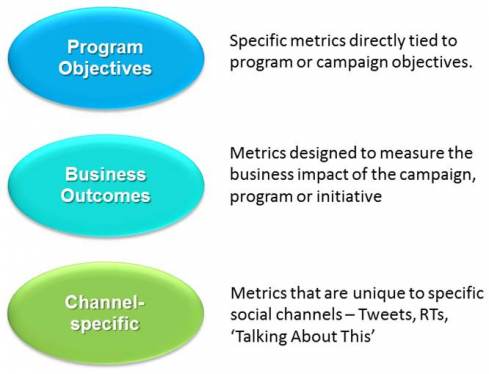This post first appeared on: http://metricsman.wordpress.com/2012/02/20/three-fundamentals-of-great-social-media-measurement/
If you want to evaluate the robustness and effectiveness of your approach to social media measurement, ask yourself these three fundamental questions:
- Does the approach measure the ‘right’ things in order to show the business impact of the programs and initiatives?
- Will stakeholders of the report receive the data and actionable insights required to make strategic decisions?
- Are the data and insights presented in a clear and concise manner that tells a story and makes it easy to understand and act upon?
Measuring the ‘Right’ Things
Social media metrics are derived from three primary sources:
Ideally, a robust social media measurement program will have a rich metrics set that contains metrics from all three areas. Metrics tied to program objectives allow for direct measurement of program success. Fundamentally, measurement is about assessing performance against objectives. It is surprising how often social program objectives are slanted toward channel-specific metrics (e.g. Likes or Followers) and not the specific outcomes desired for the program – what you hope to accomplish by implementing the program. Also, relying too heavily on channel metrics limits you to what you can measure rather than what you should measure. Business outcome metrics are used to connect the dots between social media programs and the business results they are designed to drive. Social programs that cannot answer, or at least address, the management question, “How is this impacting my business”, are more susceptible to resource allocation scrutiny (#pleasecutmybudget). Stated another way, if management asks how we’re doing in social media and we reply, “great, post virality is up 6.1% this month”, we make it difficult for that individual to understand how social media/business initiatives are helping move the business forward.
Getting to Data and Insights that Inform Strategic Decisions
Expectations for social media measurement and analysis have risen. In addition to sound analysis and reporting of performance against key metrics and KPIs, understanding audience dynamics and developing actionable insights are rapidly becoming de rigueur. Insights may be defined as synthesizing and interpreting data to provide actionable information and knowledge that informs strategic decisions. Too many social media measurement programs take a social-centric rather than a business-centric approach to insights. They often feature insights and recommendations that are tactical in nature – the best time of day or how many times to tweet, or what type of content seems to be most successful. Ideally, insights and recommendations in social measurement reports would be operating one level above this, informing strategic decisions about how social programs and conversations are impacting, or could impact, the business. To do this requires an understanding of the business function (e.g. marketing, customer service) impacted by the social program and an ability to ask the right questions prior to starting a social media analysis.
For example, let’s say Company X plans to introduce a new video game. A social listening program has been implemented to analyze the early consumer reaction to the game. Based on the listening analysis, changes to the packaging, marketing or even the product itself are possible. If you are in charge of the marketing campaign for the game, what are the types of social media insights you need to make decisions about the game and the marketing campaign?
- What is the level of buzz about the game? What is the overall sentiment? How does this compare to previous game launches?
- What are people talking about in social media – availability, cost, specific features of the game, packaging, marketing campaign?
- What features of the game do consumers seem to like most? Least? Specifically, what do they like or dislike?
- What are the most influential gaming enthusiasts saying about the product?
- Who are the promoters and detractors? What is the ratio of promoters to detractors? How does this compare to promoters and detractors from previous game launches?
- How much social media conversation contains recommendations or expresses purchase intent? How does this compare to previous launches?
Answering these types of questions provides actionable insights that provide context and can inform strategic marketing decisions.
Presenting Results
Dashboards have gotten a bit of a bad rap – not because dashboards are not useful, but because some have used them as THE measurement report rather than just one aspect of a good report. I’m a dashboard proponent for a few reasons:
- Deciding which metrics to feature on a dashboard is a good strategic exercise requiring you to focus on the very most important and relevant metrics for the intended audience
- Online, dynamic dashboards are an effective user interface that can be used as a launching- off point for drilling into data to understand the underlying story
- Good dashboards present a snapshot of overall performance that is easily absorbed and understood.
A dashboard-driven social media measurement report is versatile and effective in many situations. A typical report might consist of one of more dashboards and then a deeper dive on each of the key metrics featured on the dashboards, along with audience insights, strategic insights and recommendations. This format provides a quick snapshot (dashboard) of results, ideal for those stakeholders interested only in topline data, and provides sufficient depth to satisfy those more interested in the underlying drivers of the metric
Social media measurement programs that are built around metrics tied to business outcomes and show how programs are performing against objectives are important. Reports that deliver clear insights that inform strategic decisions are important. And delivering those reports in a compelling format that enhances usability and effectiveness is important. How do your programs stack up?



